by Lelde Beņķe, RIGA
An iconic catering establishment: the Latvian ēdnīca
A few years ago, I could have told you about the hottest new openings in Riga. I’d add them to my list of cafés, restaurants and coffee shops to try, only to get FOMO because I could never test them all anyway. If I tried somewhere and liked it, I’d be torn between returning or opting for the next shiny new toy on the list. While I strongly agree that variety is the spice of life, I also believe that too much of a good thing is a fast route to being overwhelmed.
For brain bandwidth and budget-saving purposes, I started to return to the reliable and ever-present ēdnīca (cafeteria) for the occasional weekday lunch when all I really needed was fuel to power me through the rest of the day.
Recently, fate connected me to Lija Alpa, the proud owner of an ēdnīca her customers refer to fondly as the “workers’ restaurant”.
She learned the ropes of running a major catering operation at the Ādaži kolkhoz near Riga where they fed around 1,000 mouths a day, delivering the food to the workers in the fields in huge military pots. For a time, Lija was also the resident chef for the Finnish ambassador to Latvia.
“Why do I have an ēdnīca? Because I know what it means to run a restaurant,” she smiles. With the ēdnīca Lija knows that she will have 80 to 100 customers passing through every day. By the end of service, she is left with nothing more than “serviettes and a smile. And maybe one meatball.”
To Lija, “bistro is a swear word”, hinting at her love for local cuisine, suppliers and consistency. I wanted to know how she feels about the future of the iconic establishment in light of ever-changing dietary fads, design trends, “Instagramability” and globalisation.
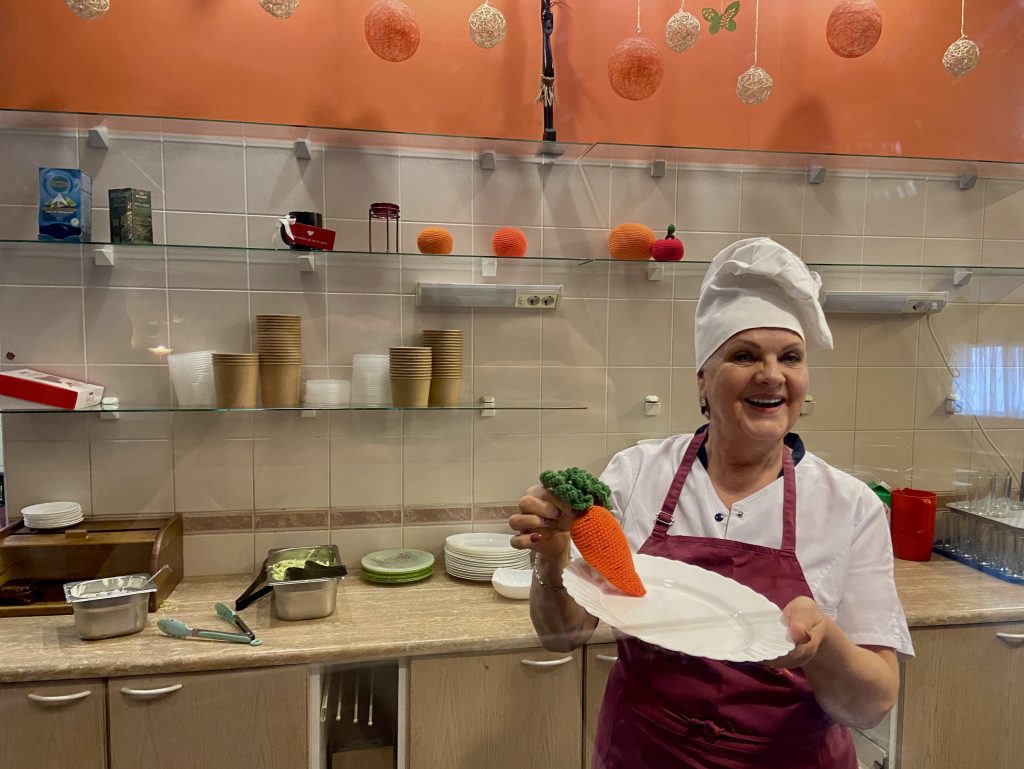
A brief introduction to the ēdnīca
But let’s start with an attempt to describe the ēdnīca. As somewhere you go to eat, not to dine, it is usually found in or near office buildings, industrial parks, and educational and healthcare institutions.
As a functional establishment, the ēdnīca delivers a more or less streamlined and standardised experience designed to ensure speedy turnarounds. You take a tray, line up and eye up what you want from the day’s spread. The queue weaves its way past a set of counters – usually one for hot mains and sides, one for salads, and another for desserts and pre-poured drinks like kefir, kompot and tomato juice. You shout out what you want, and the staff assembles your personalised portion. Tray loaded, you reach the till, where the cashier calculates the price.
After eating, you seek out the rack or nook for placing dirty trays and dishes. Nowadays, few ēdnīcas retain the once-common conveyor belt for trays, like the ones you see at modern Ikea stores.
Design-wise, the ēdnīca is less about form and more about function. Net curtains, potted plants and paper doilies are common decorative elements.
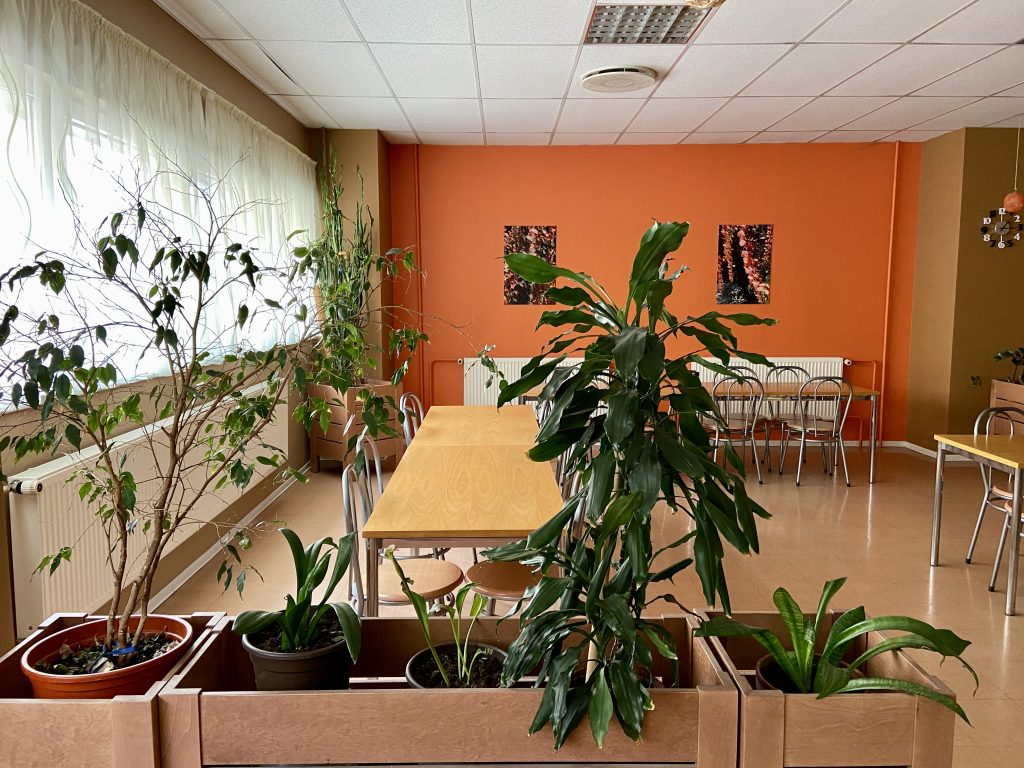
What you might expect to eat at an ēdnīca
The menu is relatively predictable, with one or two soups, a selection of meat and fish dishes for protein, and carbs, salads and sauces on the side. Even today, a vegetarian, let alone vegan protein alternative is not a given. Along with being rich, creamy and delectable, the desserts tend to trigger nostalgia.
Let’s say you’re really hungry and go for a three-course deal. You might start with a biešu zupa (beetroot soup), continue with a kotlete ar kartupeļiem (meatball and potatoes) and end with a šokolādes krēms (chocolate pudding).
Latvians first experience the ēdnīca at kindergarten or school. I have fond memories of the one Thursday a month at high school when the cooks would produce mountains of thick, squidgy, minimally nutritious yeast pancakes. The corridors would fill with the irresistible scent of fried gluten, luring us to the basement dining hall. On pancake day it didn’t matter that your clothes would reek of oil.
While some may graduate from school never to return to the ēdnīca, forsaking it for the now-widespread cafés and restaurants, others stay loyal to the former, leaving the latter two for special occasions.
An ēdnīca is a distant relative of the restaurant
Lija once owned four ēdnīcas across the city, but now runs one – Gribi ēst? Nāc pie mums! (Hungry? Come to Us!) – in an office building in the Riga neighbourhood of Imanta. She emphasises that her business is neither a restaurant, nor a café*: “I run an ēdnīca. A café is where you serve alcohol. I don’t – we’re nutty enough without it.”
“At a restaurant, we don’t just pay for the meat, the parsnip puree and the drop of balsamico. We pay for the service, serviettes and atmosphere. Here, people want to be done before they’ve had the chance to say hello,” Lija says.
At her ēdnīca, everything is freshly made from scratch on the day. “When I get offered broccoli soup in ten minutes at a restaurant, I smile. It has to be either pre-made or come from the freezer. You can get all sorts of soup mixes that you blend with water. But our food comes with the energy we put into it – the humour, debates and arguments about seasoning.”
Once, Lija joined her son for lunch at a trendy place on Skolas iela, a central street in Riga, and noted how long they stood in line and how long the staff spent chatting with them. “Forty minutes later we hadn’t even started eating yet! At my place, people are done in 40 minutes. Between 11:45 and 13:30, I have a queue. A hundred people pass through, and I serve 13 or 14, not one or two dishes,” she explains.
Thanks to the counter service, Lija gets to be in direct contact with her staff and her customers. “I need to be on stage – it gets me moving. At a restaurant, the chefs work like hell but the waiters get all the credit,” she laughs.
Serving lunch for hasty people
Along with a set lunch, Lija’s ēdnīca offers several meat and fish dishes you can buy by the gram. “I don’t serve so-called “complex lunches”* because no one here has complexes. I serve lunch for hasty people who don’t have time to choose,” Lija describes the approach and mentions one of their trademarks: “on Wednesdays we have cottage cheese fritters and on Fridays we serve homemade French fries.”
Her customers are mostly people who work at the offices and workshops nearby, and some have been coming for nine or ten years. “They’re like family,” Lija says. “People sometimes ask why we have this one dish – šķiņķīši Reiņa gaumē (chicken à la Reinis). Well, because he likes it,” she laughs. Reinis is a customer.
Lija doesn’t know every customers’ name, but recognises the regulars. “We have a chat. I notice if they’ve been to the hairdresser’s. I know what I can and can’t afford to say,” she says about the level of familiarity.
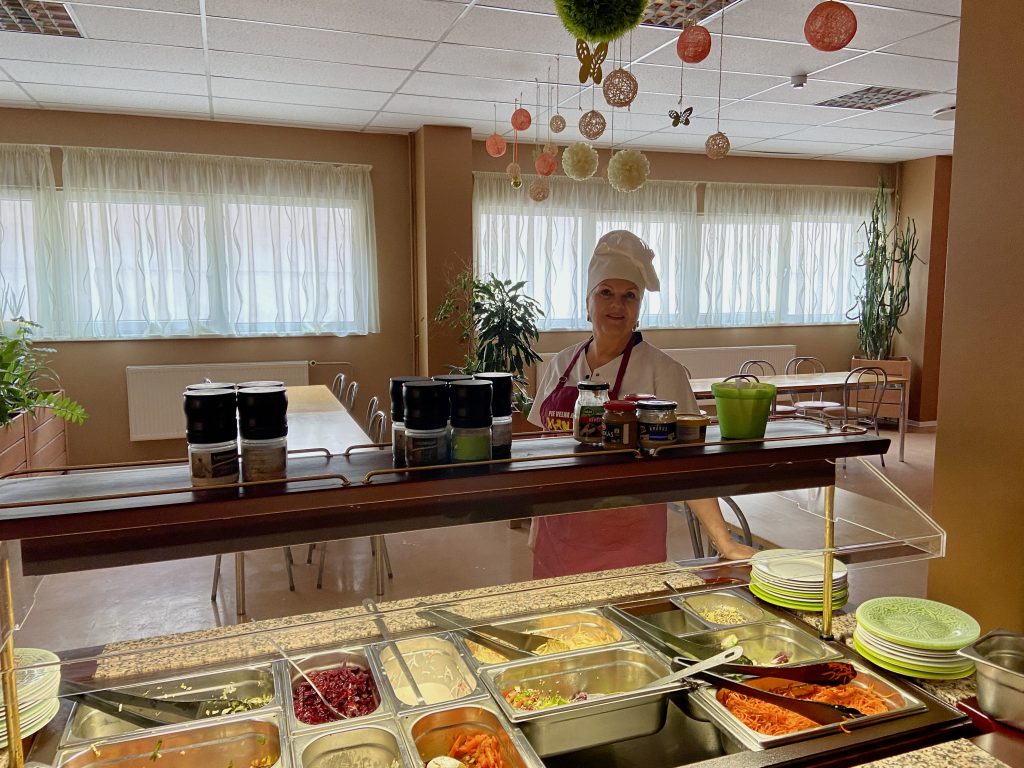
Most find out about her ēdnīca by word of mouth. “My work does the talking,” Lija says and presents a refreshingly realistic perspective on growth: “I get offered advertising but I’m aware of where we are, and I understand the capacity of my team of two and a half plus an accountant.”
Over the years, she’s made many observations, and developed a solid understanding of her customers’ needs. “People need to see things. Half won’t even read the menu. They speak to me. If anyone asks ‘what’s good on today’s menu?’ I don’t know what to say because all I have left at the end of the day is empty plates and serviettes! If I do have a bit of yesterday’s soup left over, I sell it at half price. If people remark on that, I ask what they do with leftovers at home – pour them down the drain or call their neighbours over for lunch?”
People come for food and a smile
“If you’d ask any of my long-term customers to name the colour of our walls, they’d have to think about it. They come to me because I’m nice. It’s my job. Of course, they expect clean utensils. I have a dishwasher that ends the cycle at a 92-degree temperature. When someone wipes a fork, I smile. It doesn’t upset me,” Lija shares.
Occasionally, people question the cost of their meal. “People seem to wonder why my kotletes cost 1.50 euros. They say they can buy 300 grammes of meat for that. So I tell them – no problem, take a calculator and add up the time, cost of the journey, water, electricity and labour. I reckon your meatball will be more expensive than mine. In that sense, the ēdnīca is a great help for young mothers and women,” Lija explains.
“Sometimes I think I could ask for more because my rent was raised, but I can’t afford to raise the price of my hasty lunch deal. Out of respect for myself and my customers. There has to be an alternative despite the inflation,” she is honest.
What does the future hold for the ēdnīca?
Having worked in the field for so long, Lija has developed a kind of internal trend filter. She is open-minded and well-aware of industry developments but also has the confidence not to jump on every bandwagon.
Technology is something Lija is open to, as it eases logistics and communication. “My son posts our menu online, and a few companies place their orders in advance,” she mentions as an example. However, she also sees how far we have allowed it to infiltrate our lives.
“I offer to place mobile phones in a box. People aren’t able to focus on the food, how it smells, looks and tastes. I’ll ask what someone had and they’ll say it was good whatever it was. The problem is the amount of information. People are dazed,” Lija observes, but she believes that we will get back to basics to some degree.
“When I read about beef spending 18 hours in the oven at 40 degrees, I instantly calculate how much electricity that means and how much the meat ends up costing. Is it really worth it?” she asks. At the same time, she is not averse to trying new things if they make sense. “We put some pak choy in our salad bar. Customers would ask what it was, so I’d give them 100 grammes. We do get people to try new things.”
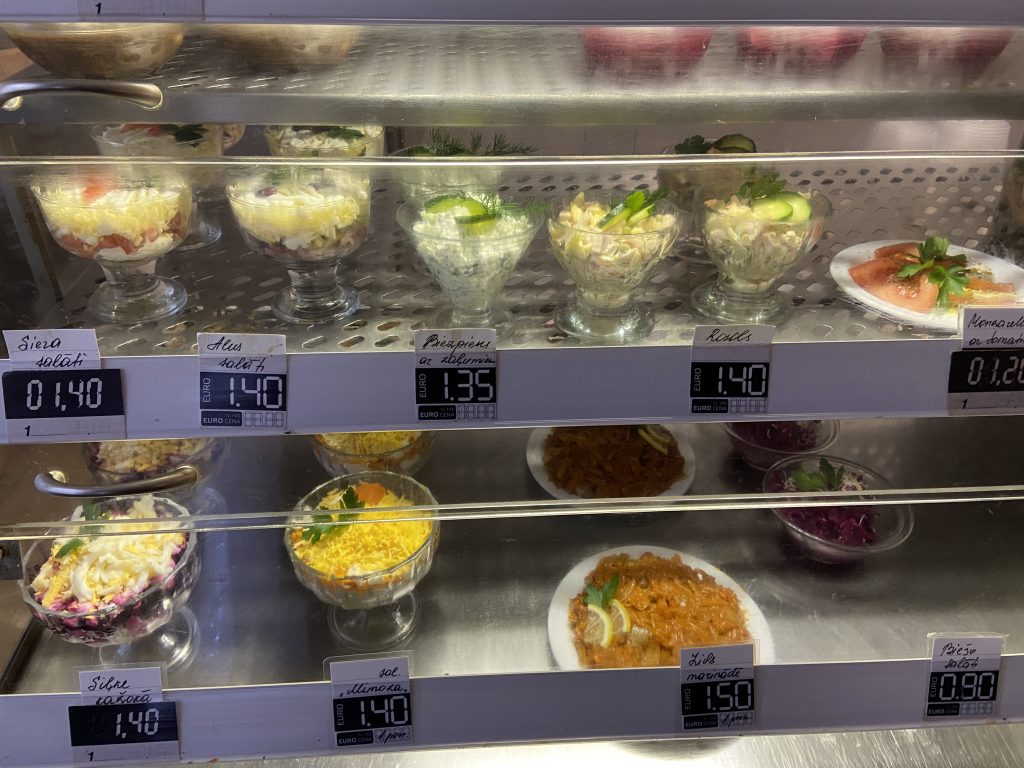
Speaking of new things, Lija recalls when diets were driven by medical reasons, but these days she sees them as more of a status thing than a necessity. “There have been all sorts of movements – vegetarianism and veganism have slowed down a bit. You have to be honest with yourself. Right now, people want to get back to the kotlete and karbonāde, and those aren’t swear words! They’re tired of all the foreign nonsense.”
This echoes my friend Linda’s story. The ēdnīca at her office got a facelift a few years ago and now serves more “contemporary” and international cuisine that comes with a higher price tag. Instead of eating there, Linda walks five minutes down the road to the nearest ēdnīca. “All I want is something simple and substantial to help me power through the rest of the day,” she said, praising the karbonāde.
Whatever the future holds, Lija is sure that the ēdnīca will survive, transforming with times and maybe even growing stronger. “It’s like when you boil stock. First, you get two rounds of foam, and then, once it’s boiled for long enough and acquired much more flavour, what you get is called consommé,” she says, adding yet another gem.
Ēdnīcas to try
In Riga:
Gribi ēst? Nāc pie mums! at Kleistu iela 24
Nokroko at Kronvalda bulvāris 1a
Veronika at Ganību dambis 18c
Laroka at Pulka iela 3
Nāc un ēd at several locations
The vintage experience: Lauktehnikas ēdnīca at Aviācijas iela 8d, Jelgava
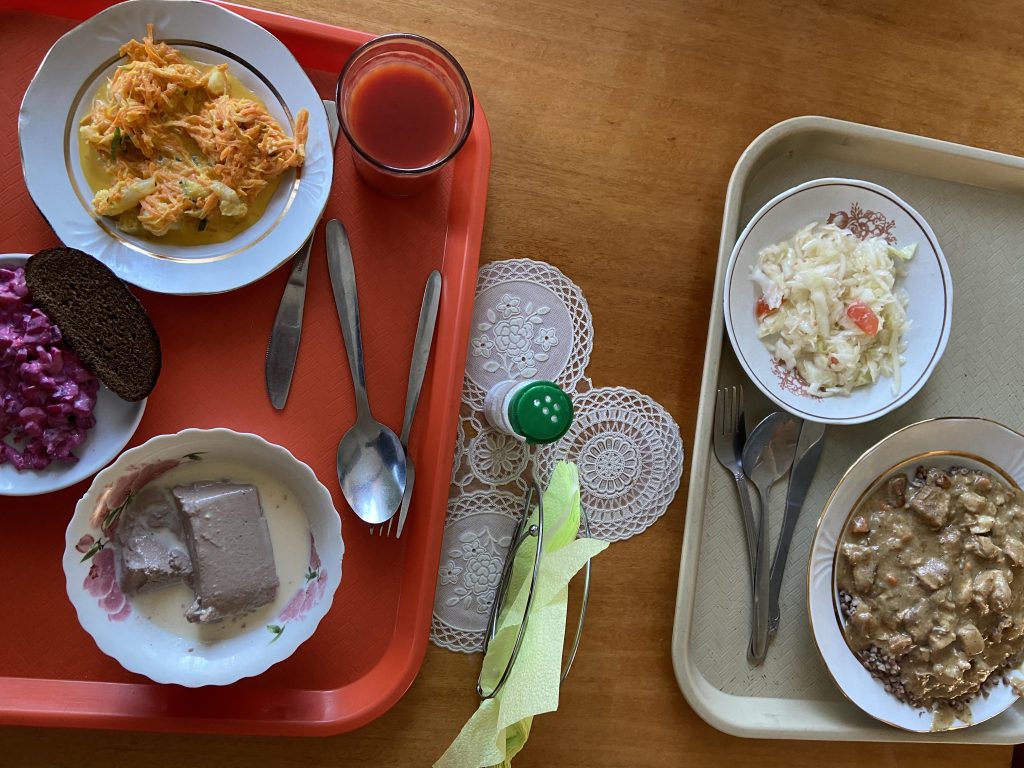
* The Latvian kafejnīca (café) is not just somewhere you go for coffee and a cake. It’s more like a less formal and fancy version of the restaurant.
* Kompleksās pusdienas (complex lunch) was once a popular term to describe a set lunch in Latvia. It’s usually a two or three course meal served quickly because it’s been pre-prepared. Today, the expression is often replaced with alternatives like biznesa pusdienas (business lunch) or pusdienu piedāvājums (offer of the day).
All images credit – Lelde Beņķe
Lelde Beņķe is a writer and content producer with a focus on stories from and about Latvia. She runs LifeinRiga.com – a hybrid of an expat blog and guide book.
© Deep Baltic 2023. All rights reserved.
Like what Deep Baltic does? Please consider making a monthly donation – help support our writers and in-depth coverage of Estonia, Latvia and Lithuania. Find out more at our Patreon page.




